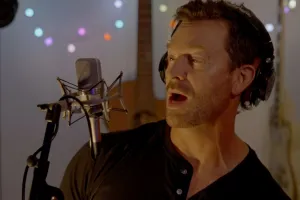
© Alistair 2008
Comprising nearly 3,000 shows in total, at over 270 venues (see our infographic for further eye-watering stats) – there is no doubting that from the acorn of the original eight shows in 1947, a rainforest of oak trees has now grown across the Scottish capital.
On Twitter last night I waded into a debate between Dessau, who writes for the Evening Standard and Guardian among others, and producer James Seabright, one of the most prolific Fringe producers under the banner Festival Highlights.
Their discussion came in the wake of a blog Dessau posted on his website Beyondthejoke.co.uk under the title ‘Is The Edinburgh Bubble About to Burst?’
In it, Dessau talks of his frustration at being bombarded with so many requests to review shows at this year’s Fringe, to the point that, for the first time, he’s not responding to some of them at all. “There are around 600 shows at the last count and I’ll have space and time to review, at best, 30 shows”, he seeths. “Do. The. Math.”
And he fires a warning shot against companies and comics hoping to be the ‘next big thing’ this year: “If you are there to be discovered or get a rave review on your very first visit think again. Edinburgh is now just too big and sprawling for that sort of fairy story to happen.”
But is he right?
On Twitter, Seabright raised the point that one problem is the major critics’ tendency to move as a herd. “Solution? Critics could review wider selection of shows,” he wrote.
But I posited in reply that it seems to me Edinburgh is one place that critics do tend to spread their bets a little more evenly, though admittedly the Traverse and EIF can always be guaranteed coverage in the nationals.
I phoned Seabright – who is producing 13 of the 2,871 shows at this year’s Fringe (a mix of comedy, theatre and cabaret) – for a follow-up chat this morning, and here’s what he said:
“It almost becomes a sport, whereby the good critics weigh in on the ‘buzz’ acts of the year, which in comedy terms undoubtedly leads to a narrower range of shows being reviewed.
But then conversely there is also an argument that, by virtue of a wider group of shows being reviewed on the theatre side, it’s increasingly difficult for emerging companies to break through as the coverage is less concentrated.”
I asked if he thought that in order to rectify this, theatre needs an equivalent of the Edinburgh Comedy Award to focus critics’ attention.
“That’s tricky, because they’re very different mediums. The Comedy Award can lead to people getting exposure on TV and other media, whereas there isn’t a comparable version of that in the theatre world. Besides, shows that successfully make the transfer from fringe venues to mainstream theatres are few and far between.
But the headline problem for both theatre and comedy is that both have mushroomed, whereas the amount of column inches have shrunk. The result is that it’s much harder to make a splash in either artform, through traditional means at least.”
So how do you make a splash these days? Seabright reckons social media and word of mouth have become increasingly important. But can either of these compare to a five star rave in The Times? Doubtful.
The story of Tom Stoppard‘s discovery has entered Fringe folklore – Observer critic Ronald Bryden’s rave about the 1966 Fringe premiere of Rosencrantz and Guildenstern Are Dead kick-started the 29-year-old playwright’s career, despite an audience of only one at its first performance.
But what I find fascinating about this tale is not Bryden’s rave, but the fact that Stoppard’s play was also covered (less glowingly) by at least three other major papers. Would that happen at today’s Fringe? Not likely, unless it happened to star a big name comic and premiere at the Assembly Rooms.
“It seems to be increasingly the case that critics have a calendar they’re working to, or a shortlist of shows that they’re planning to see,” says Seabright, “and as a result there’s a panic among producers and PRs regarding whether they’re on that shortlist.”
Untameable?
Taking a different line is critic Matt Trueman, a five-time winner of the Allen Wright Award (for young arts journalists at the Fringe), who argues that unknown companies stand as good a chance of discovery at the Fringe as ever.
“Yes, the Fringe is now too big and too commercial, and there’s a huge amount of pressure in terms of the financial side,” he tells me. “But, amongst the companies that do get up there, there is absolutely still a chance to be discovered. It’s still a great platform.”

Trueman cites companies such as The TEAM, Little Bulb and 1927 as recent examples. And when I posit that the Tom Stoppard of today would stand little chance of discovery, he fires back that Will Adamsdale won the Perrier in 2004 after a week-long run that got spotted by comedian and Fringe opinion-former Stewart Lee.
Fair point. But is the Fringe in danger of becoming untameable, as it grows exponentially and increasingly fractures into a series of micro-festivals?
Bruce Dessau, citing the increasingly sprawling Free Fringe as an example, is damning: “The exponential growth is surely unsustainable. The bubble, I’m afraid, has to burst at some point.”
But Trueman – who reviewed 50 shows last year – is more chipper. “It’s been untameable for ages, but I find this brilliant. There are at least 140 shows this year that I thought looked interesting, and there will be 100 more that I haven’t heard of yet.
“There’s something about the scale and unmanageability of it that throws it open to the free market. The wisdom of crowds comes into it, and there’s no predicting where lightning is going to strike each year.”
And James Seabright points out that exponential growth does have its up sides, in that it means more practitioners are at the Fringe each year to see each other’s work, generating greater buzz as a result.
“The Edinburgh audience are important opinion-makers, because they come from all over the UK and carry influence and word of mouth,” he says. “I find that the shows that work at Edinburgh are usually always the ones that also work on tour.”
So in the end it boils down to perspective. Whether you’re bombarding journalists with press releases, or under bombardment yourself (as I am currently), it seems there is still a crucial ingredient that keeps us going to Edinburgh each year – the thrill of the new, and the hope of its discovery.
See the full Festival Highlights programme at festivalhighlights.com













